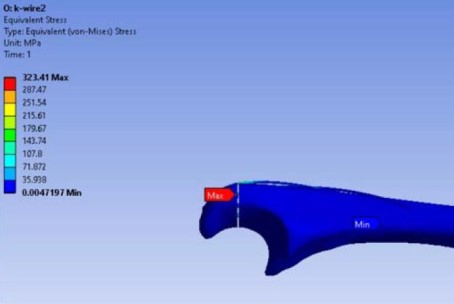USE OF TENSION BAND WIRING TECHNIQUE IN PROXIMAL ULNAR FRACTURES: A FINITE ELEMENT BIOMECHANICAL ANALYSIS
DOI:
https://doi.org/10.55374/jseamed.v6i0.99Keywords:
Tension band wiring, Olecranon fracture, Proximal ulnar fracture, Biomechanical study, Finite element analysisAbstract
Background: Tension band wiring is considered the standard treatment for olecranon fracture. A recentstudy proved that it can be used for the fracture as distal to the coronoid process.
Objective: The study aimed to investigate whether tension band wiring can be used in proximal ulnarfracture fixation up to and distal to the coronoid process.
Methods: Models of simple proximal ulnar fracture including 4 intraarticular and 2 extraarticularfractures were created. Fixation was completed using tension band wiring technique, and biomechanicalresponses were evaluated using finite element analysis. After a physiologic load was applied, thefracture displacement, von Mises stress, and stiffness were recorded.
Results: All fracture models were able to withstand the load of daily activities with a maximumdisplacement of 50% of the articular surface. In addition, the von Mises stress was the highest in themiddle articular fracture. The mean transcortical K-wire tension band wiring stiffness of the intraarticular and extra-articular fractures was 1144.89 N/mm and 1231.45 N/mm, respectively.
Conclusion: Tension band wiring is another option to treat proximal ulnar fractures with the ability towithstand immediate postoperative load.
Downloads
Metrics
References
Wilson J, Bajwa A, Kamath V, Rangan A. Biomechanical comparison of interfragmentary compression in transverse fractures of the olecranon. J Bone Joint Surg Br 2011; 93: 245-50.
Baecher N, Edwards S. Olecranon fractures. J Hand Surg Am 2013; 38: 593-604.
Kuru T, Mutlu İ. Suture anchor fixation may be an alternative to tension band wiring in olecranon fractures: Finite element analysis. Jt Dis Relat Surg 2020; 31: 238-45.
Brink PR, Windolf M, de Boer P, Braunstein V, Schwieger K. Tension band wiring of the olecranon: Is it really a dynamic principle of osteosynthesis? Injury 2013; 44: 518-22.
Buijze G, Kloen P. Clinical evaluation of locking compression plate fixation for comminuted olecranon fractures. J Bone Joint Surg Am 2009; 91: 2416-20.
Morrey BF. The elbow and Its disorders. 3rd Edition. Philadelphia: W B Saunders, 2000.
Macko D, Szabo RM. Complications of tension-band wiring of olecranon fractures. J Bone Joint Surg Am 1985; 67: 1396-401.
Powell AJ, Farhan-Alanie OM, Bryceland JK, Nunn T. The treatment of olecranon fractures in adults. Musculoskelet Surg 2017; 101: 1-9.
Bosman WPF, Emmink BL, Bhashyam AR, Houwert RM, Keizer J. Intramedullary screw fixation for simple displaced olecranon fractures. Eur J Trauma Emerg Surg. 2020; 46: 83-9.
Bailey CS, MacDermid J, Patterson SD, King GJW. Outcome of plate fixation of olecranon fractures. J Orthop Trauma 2001; 15: 542-48.
Newman SD, Mauffrey C, Krikler S. Olecranon fractures. Injury 2009; 40: 575-81.
Tarallo L, Mugnai R, Adani R, Capra F, Zambianchi F, Catani F. Simple and comminuted displaced olecranon fractures: A clinical comparison between tension band wiring and plate fixation techniques. Arch Orthop Trauma Surg 2014; 134: 1107-14.
Hammond J, Ruland R, Hogan C, Rose D, Belkoff S. Biomechanical analysis of a transverse olecranon fracture model using tension band wiring. J Hand Surg Am 2012; 37: 2506-11.
Schliemann B, Raschke MJ, Groene P, Weimann A, Wähnert D, Lenschow S, et al. Comparison of tension band wiring and precontoured locking compression plate fixation in Mayo type IIA olecranon fractures. Acta Orthop Belg 2014; 80: 106-11.
Duckworth AD, Clement ND, White TO, Court-Brown CM, McQueen MM. Plate versus tension-band wire fixation for olecranon fractures: A prospective randomized trial. J Bone Joint Surg Am 2017; 99: 1261-73.
Hutchinson DT, Horwitz DS, Ha G, Thomas CW., Bachus KN. Cyclic loading of olecranon fracture fixation constructs. J Bone Joint Surg Am 2003; 85: 831-37.
AO Foundation. Tension band wiring. Available from https://surgeryreference.aofoundation.org/orthopedic-trauma/adulttrauma/proximal-forearm/ulna-articularolecranon/tension-band-wiring#tensionband-principles. Accessed April 1, 2021
Renee D. Rogge, PhD, Brian D. Adams. An analysis of bone stresses and fixation stability using a finite element model of simulated distal radius fractures. J Hand Surg 2002; 27: 86–92.
Lin Y, Sun MT, Chen AC, Sun MT, Chen ACY. Biomechanical analysis of volar and dorsal double locking plates for fixation in comminuted extra-articular distal radius fractures: A 3D finite element study. J Med Biol Eng 2012; 32: 349–56.
Schuett DJ, Hake ME, Mauffrey C, Hammerberg EM, Philip F Stahel PF, Hak DJ Current treatment strategies for patella fractures. Orthopedics 2015; 38: 377-84.
Kakazu R, Archdeacon MT. Surgical Management of Patellar Fractures. Orthop Clin North Am 2016; 47: 77-83.
Benjamin J, Bried J, Dohm M, McMurtry M. Biomechanical evaluation of various forms of fixation of transverse patellar fractures. J Orthop Trauma 1987; 1: 219-22
Petrie J, Sassoon A, Langford J. Complications of patellar fracture repair: treatment and results. J Knee Surg 2013; 26: 309-12.
Baran O, Manisali M, Cecen B. Anatomical and biomechanical evaluation of the tension band technique in patellar fractures. Int Orthop 2009; 33: 1113-17.
Kibar B, Kurtulmuş T. Treatment of adult isolated ulnar diaphyseal fractures: A comparison of new-generation locked intramedullary nail and plate fixation. Eklem Hastalik Cerrahisi 2019; 30: 246-51.
Edwards SG, Cohen MS, Lattanza LL, IorioML, DanielsC, LodhaS. et al. Surgeon perceptions and patient outcomes regarding proximal ulna fixation: a multicenter experience. J Shoulder Elbow Surg 2012; 21: 1637-43.
Lin CL, Lin YH, Chen AC. Buttressing angle of the double-plating fixation of a distal radius fracture: A finite element study. Med Biol Eng Comput 2006; 44: 665-73.
Cheng HY, Lin CL, Lin YH, Chen ACY. Biomechanical evaluation of the modified double-plating fixation for the distal radius fracture. Clin Biomech (Bristol, Avon) 2007; 22: 510-17.
Crozier-Shaw G, Mahon J, Bayer TC. The use of bioabsorbable compression screws & polyethylene tension band for fixation of displaced olecranon fractures. J Orthop 2020; 22: 525-29.
Chao P, Conrad BP, Lewis DD, Horodyski M, Pozzi A. Effect of plate working length on plate stiffness and cyclic fatigue life in a cadaveric femoral fracture gap model stabilized with a 12-hole 2.4 mm locking compression plate. BMC Vet Res 2013; 9: 125.
Gautier E, Sommer C. Guidelines for the clinical application of the LCP. Injury 2003; 34 (Suppl 2): B63-B76.
Kubiak EN, Fulkerson E, Strauss E, Egol KA. The evolution of locked plates. J Bone Joint Surg Am 2006; 88 (Suppl 4): 189-200.
Lill H, Hepp P, Korner J, Kassi JP, verheyden AP, Josten C, et al. Proximal humeral fractures: how stiff should an implant be? A comparative mechanical study with new implants in human specimens. Arch Orthop Trauma Surg 2003;123: 74-81.

Downloads
Published
How to Cite
Issue
Section
License
The Journal of Southeast Asian Medical Research will hold the copyright to all published articles. The publisher's production department handles copyright forms once a manuscript is accepted and scheduled for publication.







